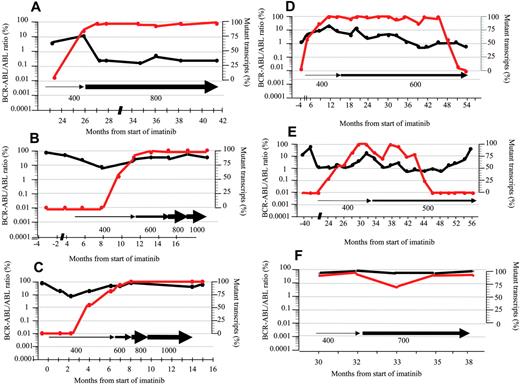We report results of monitoring BCR-ABL transcript levels in 6 patients with chronic myeloid leukemia (CML) treated with imatinib mesylate (IM) who were found to have the same BCR-ABLM244V mutant allele. In vitro data suggest that this mutation is moderately resistant to IM, with an inhibitory concentration at 50% (IC50) of 4.1 μM,1 and that resistance may be overcome by dose escalation.2,3 In practice, the response to increasing the doses of IM varied in the 6 patients (Figure 1), an observation that can be interpreted in 1 of 3 ways: (1) the degree to which the mutation confers resistance to IM is very variable in different patients; (2) the presence of a M224V mutant may not always be the direct cause of the resistance; or (3) differential responses are due to very different pharmacokinetics of IM in the different patients.
The samples that we used in this study were either extracted RNA or cells in GTC and were surplus material from routine samples taken for monitoring. Since 2001, we have had an ethically approved process for consenting patients for the use of such “waste” material but which requires the individual studies to be ethically approved. The consent implies that the material is used in collaboration with a member of our department. The levels of wild-type and mutant BCR-ABL transcripts were quantified by real-time quantitative polymerase chain reaction (RQ-PCR) and quantitative single nucleotide polymorphism (Q-SNP) pyrosequencing, which in our hands has a sensitivity of 5%,4 in all available samples (median number, 15 per patient; range, 5-27 per patient). After an initial reduction in leukemia-cell load on IM 400 mg/day, increasing the dose in 3 of the 6 patients resulted in a further decrease in BCR-ABL transcript numbers. Two of these patients achieved complete cytogenetic remission (CCyR) at IM doses of 500 and 600 mg/day, respectively, and in both cases the mutant allele eventually became undetectable by pyrosequencing (Figure 1D-E). The third patient (Figure 1A) also achieved CCyR, with total BCR-ABL transcript levels stabilized at less than 1.0%, but almost all transcripts still showed the mutant allele, implying that the mutation was the cause of the observed resistance. For the other 3 patients the IM dose was increased to 1000 mg/day in 2 cases (Figure 1B-C) and to 700 mg/day in the third (Figure 1F), but BCR-ABL transcript levels were largely unchanged and consisted almost entirely of the mutant allele (Figure 1B). Furthermore, in these 3 “resistant” patients no other mutation was found by direct sequencing.
Mutated BCR-ABL clone kinetics. The figure shows BCR-ABL transcript levels as measured by RQ-PCR and the relative size of the mutant clone while the patients were being treated with IM as single agent. The black and red lines represent the total BCR-ABL transcripts and the percentage of the mutant clone, respectively. The horizontal arrows represent the duration of the IM treatment. The IM dose is indicated in milligrams per day.
Mutated BCR-ABL clone kinetics. The figure shows BCR-ABL transcript levels as measured by RQ-PCR and the relative size of the mutant clone while the patients were being treated with IM as single agent. The black and red lines represent the total BCR-ABL transcripts and the percentage of the mutant clone, respectively. The horizontal arrows represent the duration of the IM treatment. The IM dose is indicated in milligrams per day.
The data reported here show clearly that the degree to which the same mutant BCR-ABL clone is inhibited by IM differs in different patients. If these differences are not attributable to major interpatient variation in IM pharmacokinetics, then they imply that whereas the M244V mutation may be the direct cause of the IM resistance in some cases, its presence in other cases may be quite incidental, and other previously identified or unidentified mechanisms must be the principal cause of the resistance. Our observations highlight the need to study the kinetics of the mutant clone and the pharmacokinetics of the drug in patients who appear to be resistant to a given BCR-ABL mutant.


This feature is available to Subscribers Only
Sign In or Create an Account Close Modal